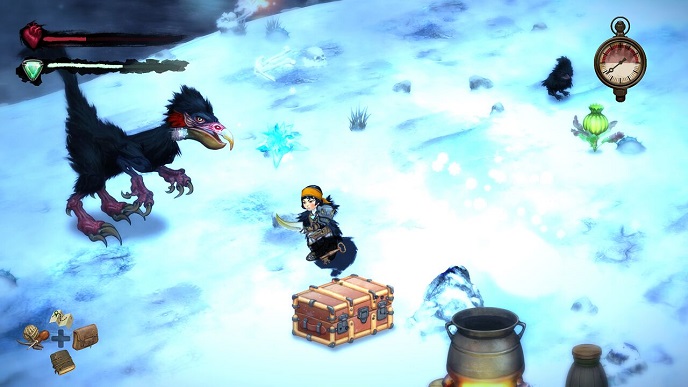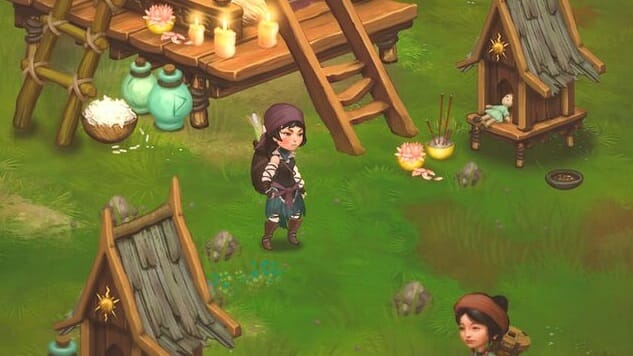I’ve written before that open world sandbox exploration games are no longer enough. As a showcase of what videogame tech can do, they’re great, but by their permissive and directionless nature, they’re not imbued with a sense of purpose. The player may do whatever they wish in them, but rarely is their environment given meaning. Instead, there’s no real value in the gameplay. There’s no sense of purpose.
As open world sandbox exploration titles gained popularity, eventually they came to be combined with crafting and survival games, which too have a tendency to wither under a lack of direction or purpose. This was my issue with perhaps one of the most famous crafting and survival games, Don’t Starve, which I initially enjoyed but grew bored of quickly. Inspired by that indie hit, Smoke and Sacrifice takes many of those same gameplay features and adds a narrative, driving the player’s motivation beyond the thrill of just seeing what they can make next, and giving them a reason to be making all those weapons and healing items in the first place. In other words, it doesn’t just give the player something to do, it gives them a reason to be doing it.
In Smoke and Sacrifice, Satchi must travel to the underworld to find out what has become of her firstborn son, Lio, who was ritually sacrificed to the Sun Cult seven years earlier. One day, during some mysterious event that has removed the sun’s light from the land, she gains access to the underworld and, suspecting that her son is still alive, ventures out to learn of his fate. Traveling through hostile plumes of poisonous smoke, she must use the resources in her surroundings to improvise the means of accessing various patches of elemental landscape, from snow, to fire, radiation, and electricity, helping others who are doomed to this strange place and getting closer to answers about her son along the way.
The grind of Smoke and Sacrifice is familiar to anyone who has played a crafting game. It’s the same process in Don’t Starve that eventually made me feel like I was going through the motions: make an item, use it to gather other items, use those items to upgrade and then create new items, until an entire pyramid of progress can be mapped out from the game’s earliest stages. While this can get repetitive, the cartoonish creep factor in the aesthetic of Smoke and Sacrifice keeps the process interesting. Inspired by everything from paganism, to the Black Plague, to the sooty streets of industrial era England, the atmospheres are dark, even weird. It’s a refreshing change of pace amid all the other lookalike Minecraft-inspired fortress simulators that have come to dominate the genre.

I’m also particularly taken with the story, which as a mother I found sympathetic and heartbreaking. The mysteries of the underworld, the truth behind the village sun cult, and the desperation to find Lio all adequately propelled my motivation to unlock the secrets of Satchi’s surroundings, and I ended up playing for much longer sessions than I generally do with other crafting and survival games.
The sad thing, however, about my theory as to purpose within sandbox and survival titles is that it can backfire. My deep interest in the story and seeing its conclusion was constantly stymied by the game’s lack of structure. It was hard at times to remember what I was supposed to be doing, or what areas certain items could be found in, and often the finer details of a mission were either never explained or only mentioned once, leading to some confusion. If there weren’t so many environmental hazards in the game, the trial and error process of figuring out some key mission objectives wouldn’t be an issue, but in Smoke and Sacrifice, time is resources. Generally you don’t have enough of either to wander around and figure out what you’re supposed to be doing, because you’ll almost instantly wear out whatever special gear you’re wearing for that particular area. The pacing leans towards frantic and the rate of item decay is exhausting. And while I did not expect the archaic save system to be too much of a problem, when combined with the constant obstacles to progress and laborious accumulation of resources (not to mention a cluttered map that doesn’t allow you to tag mission objectives or maintain any sense of direction on the game’s fixed isometric plane), I got so frustrated at times I had to put the game down and walk away.
I like Smoke and Sacrifice a lot but I don’t think I would have seen it through if I wasn’t deeply interested in enough of its parts. The story, mechanics, lore and aesthetic are all fantastic, but some simple tweaks, like improvements to the mission notes, would balance the crafting and survival aspects enough to make them less of an impediment to completion. That being said, whatever effort you put in to finish Smoke and Sacrifice will be worth it. It’s flawed, but it’s a step in the right direction for survival crafting games, and I hope to see others in its genre take the same initiative towards aesthetic and narrative in the future.
Smoke and Sacrifice was developed by Solar Sail Games and published by Curve Digital. Our review is based on the Switch version. It is also available for PC.
Holly Green is the assistant editor of Paste Games and a reporter and semiprofessional photographer. She is also the author of Fry Scores: An Unofficial Guide To Video Game Grub. You can find her work at Gamasutra, Polygon, Unwinnable, and other videogame news publications.

